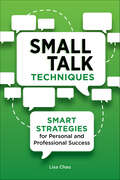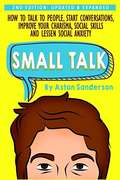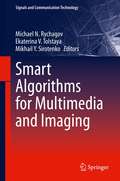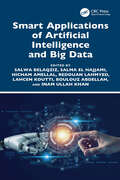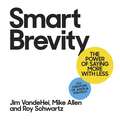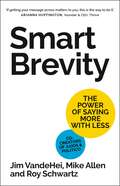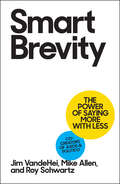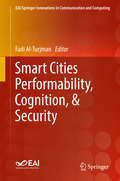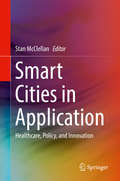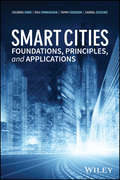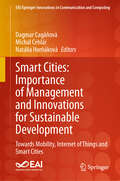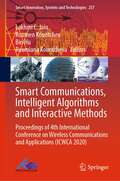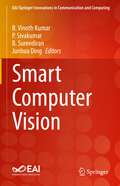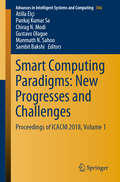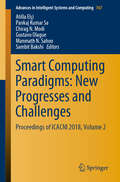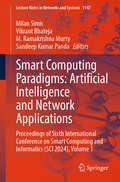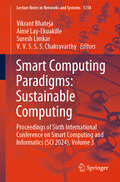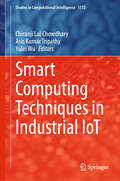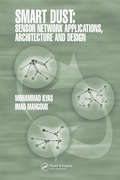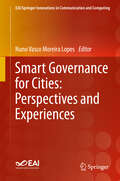- Table View
- List View
Small Talk Techniques: Smart Strategies for Personal and Professional Success
by Lisa Green ChauSimple strategies for turning small talk into an essential tool for successThe ability to engage in effective small talk is an invaluable skill for any social interaction, from casual to professional. Small Talk Techniques is your ultimate guide to becoming a pleasantries pro, with practical strategies that help you establish genuine connections and leave people with a positive, lasting impression.This book is a straightforward resource featuring clear examples and explanations for how these techniques work. You'll also find a range of simple ways to start, maintain, and exit conversations gracefully, listen actively, and keep others interested and engaged.Small Talk Techniques will help you:Navigate any conversation—Learn about the essential components of small talk like asking open-ended questions, expanding on small details, matching someone's mood, and even recovering from social missteps.Expand your network—This expert advice helps you prepare yourself for conversations ahead of time, as well as giving you the tools to make new connections on the fly, and adapt to changing social dynamics with ease.Get the truth about small talk—Break down why small talk is so important and how it opens the door for trust, credibility, and future success at work and in life.Explore how far small talk can take you, with simple strategies and examples that make it easy.
Small Talk: How to Talk to People, Start Conversations, Improve Your Charisma, Social Skills, and Lessen Social Anxiety, 2nd Edition
by Aston SandersonNever feel awkward in a small talk conversation again! If you’ve ever felt awkward when you meet new people, worrying about social anxiety, how to talk to people, and how to be interesting, this quick-read small talk guide will make you someone who people love to talk to. <P><P>*New 2nd Edition: Updated & Expanded! Includes new chapter: Small Talk for Dating and expanded chapter on Reading Body Language <P><P>If you’ve ever felt nervous before a work party, blind date, or friend’s dinner, worry no more after reading this book and getting awesome tips on improving your social skills and charisma.
Smart Algorithms for Multimedia and Imaging (Signals and Communication Technology)
by Michael N. Rychagov Ekaterina V. Tolstaya Mikhail Y. SirotenkoThis book presents prospective, industrially proven methods and software solutions for storing, processing, and viewing multimedia content on digital cameras, camcorders, TV, and mobile devices. Most of the algorithms described here are implemented as systems on chip firmware or as software products and have low computational complexity and memory consumption. In the four parts of the book, which contains a total of 16 chapters, the authors address solutions for the conversion of images and videos by super-resolution, depth estimation and control and mono-to-stereo (2D to 3D) conversion; display applications by video editing; the real-time detection of sport episodes; and the generation and reproduction of natural effects. The practical principles of machine learning are illustrated using technologies such as image classification as a service, mobile user profiling, and automatic view planning with dictionary-based compressed sensing in magnetic resonance imaging. The implementation of these technologies in mobile devices is discussed in relation to algorithms using a depth camera based on a colour-coded aperture, the animated graphical abstract of an image, a motion photo, and approaches and methods for iris recognition on mobile platforms. The book reflects the authors’ practical experience in the development of algorithms for industrial R&D and the commercialization of technologies.Explains digital techniques for digital cameras, camcorders, TV, mobile devices;Offers essential algorithms for the processing pipeline in multimedia devices and accompanying software tools;Features advanced topics on data processing, addressing current technology challenges.
Smart Antennas for 5G+
by Manos M. Tentzeris Steven R. Best Gert F. Pedersen David A. Sánchez-Hernández Sungtek KahngComprehensive reference text for the development of advanced antenna systems for 5G and beyond Smart Antennas for 5G+ addresses the transformation that simple, conventional antennas have gone through to fulfill the complex and challenging performance expectations of 5G wireless communications and beyond. It also describes the 5G physical layer including the gNodeB, basics of the propagation channel, and user equipment (UE) specific antenna aspects. The authors present various broadband antennas covering mmW bands for 5G+ and B5G applications, explore recent developments in array calibration and plane wave generators, and consider future challenges for 5G+ radio system testing. Novel key performance indicators in which not only conventional RF parameters, but also other parameters and overall radio performance, are examined. The huge shrinkage which was prioritized in 4G modules are now combined with extremely versatile and precise beamforming capacities, thermal mitigation, and link budget compensation design strategies that bring antennas into a new era. As such, antenna integration, flexible and 3D printed elements, the use of metamaterials, and advanced testing of new features are key elements of this book. Additional topics covered in Smart Antennas for 5G+ include: Beamforming, beam-steering, power control, cell breathing, and many other 5G concepts that make the evaluation of a 5G antenna structure a complex process Multi-probe anechoic chamber, reverberation chamber, and wireless cable solutions, RF testing of the 5G antenna systems, and small-cell repeaters for 5G/B5G beamforming Powering and sensing applications in 5G+ printed electronic steerable antenna arrays for reconfigurable intelligent surfaces that stem from metasurfaces 3GPP/ITU standards and models for 5G MIMO base station antennas, propagation channel modeling, and link budget considerations The connection between complex but realistically used designs and the way testing has evolved to determine the value of novel designs makes Smart Antennas for 5G+ a must-have resource for advanced engineers as well as newcomers in the field of 5G wireless communications.
Smart Antennas: Latest Trends in Design and Application (EAI/Springer Innovations in Communication and Computing)
by Praveen Kumar Malik Joan Lu B T P Madhav Geeta Kalkhambkar Swetha AmitThis book presents the latest techniques for the design of antenna, focusing specifically on the microstrip antenna. The authors discuss antenna structure, defected ground, MIMO, and fractal design. The book provides the design of microstrip antenna in terms of latest applications and uses in areas like IoT and device-to-device communication. The book also provides the current methods and techniques used for the enhancement of the performance parameters of the microstrip antenna. Chapters enhance the knowledge and skills of students and researchers in the latest in the communications world like IoT, D2D, satellite, wearable devices etc. The authors discuss applications such as microwave imaging, medical implants, hyperthermia treatments, and wireless wellness monitoring and how a decrease in size of antenna help facilitate application potential.Provides the latest techniques used for the design of antenna in terms of its structure, defected ground, MIMO and fractal design;Outlines steps to resolve issues with designing antenna, including the latest design and design parameters for microstrip antenna;Presents the design of conformal and miniaturized antenna structures for various applications.
Smart Applications of Artificial Intelligence and Big Data (Advances in Digital Technologies for Smart Applications)
by Inam Ullah Khan Salma El Hajjami Salwa Belaqziz Hicham Amellal Redouan Lahmyed Lahcen Koutti Boulouz AbdellahSmart Applications of Artificial Intelligence and Big Data covers a wide range of topics related to AI and big data, including machine learning, deep learning, natural language processing, computer vision, data analytics, and data mining. It focuses on the integration of these technologies to create smart applications, such as intelligent transportation systems, smart healthcare, smart cities, and smart grids.This book comprises 21 chapters, each providing technical details pertaining to research, practical examples, and case studies to help readers understand the real-world applications of AI and big data technologies. The book also highlights cutting-edge research on AI and big data, including novel algorithms, tools, and techniques. It discusses the challenges and opportunities of using AI and big data to develop smart applications and provides recommendations for the development of responsible and transparent AI-based systems. This book is a valuable resource for researchers and professionals looking to stay up-to-date with the latest advancements in AI and big data and how they can be applied to solve real-world challenges.
Smart Brevity: The Power of Saying More with Less
by Mike Allen Jim VandeHei Roy SchwartzThe guide to saying more with less.Brevity is confidence. Length is fear. This is the guiding principle of Smart Brevity, a communication formula built by Axios journalists to prioritize essential news and information, explain its impact and deliver it in a concise and visual format. Now, the co-founders of Axios have created an essential guide for communicating effectively and efficiently using Smart Brevity - think Strunk and White's Elements of Style for the digital age.In SMART BREVITY: The Power of Saying More with Less, Axios co-founders Jim VandeHei, Mike Allen, and Roy Schwartz teach listeners how to say more with less in virtually any format. They also share communications lessons learned from their decades of experience in media, business and communications.(P) 2023 Algonquin Books
Smart Brevity: The Power of Saying More with Less
by Mike Allen Jim VandeHei Roy SchwartzA WALL STREET JOURNAL AND USA TODAY NATIONAL BESTSELLER!Brevity is confidence. Length is fear. This is the guiding principle of Smart Brevity, a communication formula built by Axios journalists to prioritize essential news and information, explain its impact and deliver it in a concise and visual format. Now, the co-founders of Axios have created an essential guide for communicating effectively and efficiently using Smart Brevity - think Strunk and White's Elements of Style for the digital age.In SMART BREVITY: The Power of Saying More with Less, Axios co-founders Jim VandeHei, Mike Allen, and Roy Schwartz teach readers how to say more with less in virtually any format. They also share communications lessons learned from their decades of experience in media, business and communications.
Smart Brevity: The Power of Saying More with Less
by Mike Allen Jim VandeHei Roy SchwartzBrevity is confidence. Length is fear. This is the guiding principle of Smart Brevity, a communication formula built by Axios journalists to prioritize essential news and information, explain its impact and deliver it in a concise and visual format. Now, the co-founders of Axios have created an essential guide for communicating effectively and efficiently using Smart Brevity—think Strunk and White&’s Elements of Style for the digital age. In SMART BREVITY: The Power of Saying More with Less, Axios co-founders Jim VandeHei, Mike Allen, and Roy Schwartz teach readers how to say more with less in virtually any format. They also share communications lessons learned from their decades of experience in media, business and communications.
Smart Cities Performability, Cognition, & Security (EAI/Springer Innovations in Communication and Computing)
by Fadi Al-TurjmanThis book provides knowledge into the intelligence and security areas of smart-city paradigms. It focuses on connected computing devices, mechanical and digital machines, objects, and/or people that are provided with unique identifiers. The authors discuss the ability to transmit data over a wireless network without requiring human-to-human or human-to-computer interaction via secure/intelligent methods. The authors also provide a strong foundation for researchers to advance further in the assessment domain of these topics in the IoT era. The aim of this book is hence to focus on both the design and implementation aspects of the intelligence and security approaches in smart city applications that are enabled and supported by the IoT paradigms. Presents research related to cognitive computing and secured telecommunication paradigms;Discusses development of intelligent outdoor monitoring systems via wireless sensing technologies;With contributions from researchers, scientists, engineers and practitioners in telecommunication and smart cities.
Smart Cities in Application: Healthcare, Policy, and Innovation
by Stan McClellanThis book explores categories of applications and driving factors surrounding the Smart City phenomenon. The contributing authors provide perspective on the Smart Cities, covering numerous applications and classes of applications. The book uses a top-down exploration of the driving factors in Smart Cities, by including focal areas including “Smart Healthcare,” “Public Safety & Policy Issues,” and “Science, Technology, & Innovation.” Contributors have direct and substantive experience with important aspects of Smart Cities and discuss issues with technologies & standards, roadblocks to implementation, innovations that create new opportunities, and other factors relevant to emerging Smart City infrastructures.Features an exploration of Smart City issues and solutions from a variety of stakeholders in the evolving fieldPresents conversational, nuanced, and forward thinking perspectives on Smart Cities, their implications, limitations, obstacles, and opportunitiesIncludes contributions from industry insiders who have direct, relevant experience with their respective subjects as well as positioning and corporate stature
Smart Cities: Foundations, Principles, and Applications
by Sabina Jeschke Houbing Song Ravi Srinivasan Tamim SookoorProvides the foundations and principles needed for addressing the various challenges of developing smart cities Smart cities are emerging as a priority for research and development across the world. They open up significant opportunities in several areas, such as economic growth, health, wellness, energy efficiency, and transportation, to promote the sustainable development of cities. This book provides the basics of smart cities, and it examines the possible future trends of this technology. Smart Cities: Foundations, Principles, and Applications provides a systems science perspective in presenting the foundations and principles that span multiple disciplines for the development of smart cities. Divided into three parts—foundations, principles, and applications—Smart Cities addresses the various challenges and opportunities of creating smart cities and all that they have to offer. It also covers smart city theory modeling and simulation, and examines case studies of existing smart cities from all around the world. In addition, the book: Addresses how to develop a smart city and how to present the state of the art and practice of them all over the world Focuses on the foundations and principles needed for advancing the science, engineering, and technology of smart cities—including system design, system verification, real-time control and adaptation, Internet of Things, and test beds Covers applications of smart cities as they relate to smart transportation/connected vehicle (CV) and Intelligent Transportation Systems (ITS) for improved mobility, safety, and environmental protection Smart Cities: Foundations, Principles, and Applications is a welcome reference for the many researchers and professionals working on the development of smart cities and smart city-related industries.
Smart Cities: Towards Mobility, Internet of Things and Smart Cities (EAI/Springer Innovations in Communication and Computing)
by Dagmar Cagáňová Natália Horňáková Michal CehlárThis book features contributions focusing on innovative technologies influencing industry and connectivity sectors in industrial, urban, social and sustainable development. The contributions cover many topics in mobility, including car manufacturing, e-mobility, smart cities, smart factories (Industry 4.0), smart logistics, social mobility, technological innovations, sustainability, management and marketing, multicultural development, Internet of Things sectors, etc. The contributions are applicable to researchers, academics, students, and professionals.
Smart Communications, Intelligent Algorithms and Interactive Methods: Proceedings of 4th International Conference on Wireless Communications and Applications (ICWCA 2020) (Smart Innovation, Systems and Technologies #257)
by Lakhmi C. Jain Bin Hu Roumen Kountchev Roumiana KountchevaThis book gathers selected papers presented at the 4th International Conference on Wireless Communications and Applications (ICWCA 2020), held at Hainan University, China. The first volume of the proceedings will focus on the newest methods and algorithms in smart wireless communications in the areas of multimedia communications over wireless; smart antenna and space-time signal processing; antenna, wireless propagation, and channel modeling; OFDM and multi-carrier techniques; localization and navigation techniques; software-defined networking (SDN) and network function virtualization (NFV); knowledge-defined networking (KDN) and the applications of artificial intelligence (AI) in future networks; future data-center networks; resource allocation and orchestration in future networks and many others.
Smart Computer Vision (EAI/Springer Innovations in Communication and Computing)
by P. Sivakumar B. Vinoth Kumar B. Surendiran Junhua DingThis book addresses and disseminates research and development in the applications of intelligent techniques for computer vision, the field that works on enabling computers to see, identify, and process images in the same way that human vision does, and then providing appropriate output. The book provides contributions which include theory, case studies, and intelligent techniques pertaining to computer vision applications. The book helps readers grasp the essence of the recent advances in this complex field. The audience includes researchers, professionals, practitioners, and students from academia and industry who work in this interdisciplinary field. The authors aim to inspire future research both from theoretical and practical viewpoints to spur further advances in the field.
Smart Computing Paradigms: Proceedings of ICACNI 2018, Volume 1 (Advances in Intelligent Systems and Computing #766)
by Manmath N. Sahoo Pankaj Kumar Sa Sambit Bakshi Gustavo Olague Atilla Elçi Chirag N. ModiThis two-volume book focuses on both theory and applications in the broad areas of communication technology, computer science and information security. It brings together contributions from scientists, professors, scholars and students, and presents essential information on computing, networking, and informatics. It also discusses the practical challenges encountered and the solutions used to overcome them, the goal being to promote the “translation” of basic research into applied research, and of applied research into practice. The works presented here will also demonstrate the importance of basic scientific research in a range of fields.
Smart Computing Paradigms: Proceedings of ICACNI 2018, Volume 2 (Advances in Intelligent Systems and Computing #767)
by Manmath N. Sahoo Pankaj Kumar Sa Sambit Bakshi Gustavo Olague Atilla Elçi Chirag N. ModiThis two-volume book focuses on both theory and applications in the broad areas of communication technology, computer science and information security. It brings together contributions from scientists, professors, scholars and students, and presents essential information on computing, networking, and informatics. It also discusses the practical challenges encountered and the solutions used to overcome them, the goal being to promote the “translation” of basic research into applied research, and of applied research into practice. The works presented here will also demonstrate the importance of basic scientific research in a range of fields.
Smart Computing Paradigms: Proceedings of Sixth International Conference on Smart Computing and Informatics (SCI 2024), Volume 1 (Lecture Notes in Networks and Systems #1147)
by Vikrant Bhateja Sandeep Kumar Panda Milan Simic M. Ramakrishna MurtyThis book presents best-selected papers presented at the 6th International Conference on Smart Computing and Informatics (SCI 2024), held at the Department of Computer Science and Engineering, Anil Neerukonda Institute of Technology & Sciences (ANITS), Visakhapatnam, India, during 19–20 April 2024. It presents advanced and multidisciplinary research towards the design of smart computing and informatics. The theme is on a broader front and focuses on various innovation paradigms in system knowledge, intelligence and sustainability that may be applied to provide realistic solutions to varied problems in society, environment and industries. The scope is also extended towards the deployment of emerging computational and knowledge transfer approaches, optimizing solutions in various disciplines of science, technology and healthcare. The work is published in three volumes.
Smart Computing Paradigms: Proceedings of Sixth International Conference on Smart Computing and Informatics (SCI 2024), Volume 2 (Lecture Notes in Networks and Systems #1262)
by Ahmad Taher Azar Vikrant Bhateja Milan Simic E. Laxmi LydiaThis book presents best-selected papers presented at 6th International Conference on Smart Computing and Informatics (SCI 2024), held at Department of Computer Science and Engineering, Anil Neerukonda Institute of Technology & Sciences (ANITS), Visakhapatnam, India, during 19 – 20 April 2024. It presents advanced and multidisciplinary research toward the design of smart computing and informatics. The theme is on a broader front and focuses on various innovation paradigms in system knowledge, intelligence and sustainability that may be applied to provide realistic solutions to varied problems in society, environment and industries. The scope is also extended toward the deployment of emerging computational and knowledge transfer approaches, optimizing solutions in various disciplines of science, technology and healthcare. The work is published in three volumes.
Smart Computing Paradigms: Proceedings of Sixth International Conference on Smart Computing and Informatics (SCI 2024), Volume 3 (Lecture Notes in Networks and Systems #1318)
by Aimé Lay-Ekuakille Vikrant Bhateja V. V. S. S. S Chakravarthy Suresh LimkarThe proceeding presents best selected papers presented at 6th International Conference on Smart Computing and Informatics (SCI 2024), held at Department of Computer Science and Engineering, Anil Neerukonda Institute of Technology & Sciences (ANITS), Visakhapatnam, India, during 19 – 20 April 2024. It presents advanced and multi-disciplinary research towards the design of smart computing and informatics. The theme is on a broader front focuses on various innovation paradigms in system knowledge, intelligence and sustainability that may be applied to provide realistic solutions to varied problems in society, environment and industries. The scope is also extended towards the deployment of emerging computational and knowledge transfer approaches, optimizing solutions in various disciplines of science, technology and healthcare. The work is published in three volumes.
Smart Computing Techniques in Industrial IoT (Studies in Computational Intelligence #1172)
by Yulei Wu Chiranji Lal Chowdhary Asis Kumar TripathyThe book provides a conceptual framework and roadmap for applications and research trends in Smart Computing Techniques in Industrial IoT. This volume aims to provide information on emerging fields of intelligent computing techniques with a particular emphasis on industrial IoT development and applications of artificial intelligence, deep learning techniques, computational intelligence methods, the Internet of Medical Things (IoMT), optimization techniques, blockchain, and cloud computing. It will be a useful guide for undergraduate and postgraduate students studying artificial intelligence, deep learning, industry 4.0, industry 5.0, smart cities, machine learning, deep learning computational intelligence, and edge/cloud computing.
Smart Dust: Sensor Network Applications, Architecture and Design
by Mohammad Ilyas Imad MahgoubSensor networks continue to grow in importance for modern communication networks. The fruit of recent efforts aimed at miniaturization and highly advanced functionality, smart dust sensor networks offer powerful, cost-effective solutions to densely distributed, high-resolution applications. In chapters carefully selected from the popular Handbook of Sensor Networks, Smart Dust: Sensor Network Applications, Architecture, and Design supplies a sharply focused reference on the applications, design, and performance of smart dust that is ideal for specialists in the field. Providing a succinct survey of the principles and technologies associated with smart dust networks, this book focuses on eight main areas: applications; architecture; protocols; tracking technologies; data gathering and processing; energy management; security, reliability, and fault tolerance; and performance and design aspects. Following a look at the opportunities and challenges facing the field, expert contributors authoritatively cover sensor network management, miniaturizing sensor networks with MEMS, sensor network architecture, energy-efficient technologies, positioning and tracking, comparison of cooperative computing in sensor networks, dynamic power management, low-power design for smart dust networks, and more.Smart Dust: Sensor Network Applications, Architecture, and Design details the applications and technologies that are at the frontier of modern sensor networks. It is an ideal reference for anyone interested in designing, planning, or building emerging sensor and communications networks.
Smart Global Megacities: Collaborative Research: Chennai, Kochi-Kannur (Advances in 21st Century Human Settlements)
by T. M. Vinod KumarThis book, the second volume, highlights 7 out of a total of about 36 megacities in the World which by definition have 10 million inhabitants. The cities/chapters presented in this book are based on recent advance such as the wide use of ICT, IOT, e-Governance, e-Democracy, smart economy and flattening and acceleration of the world that is taking place in recent times as reported by 3 times Pulitzer Prize Winner Thomas Friedman. It therefor departs from other ideologies where only a certain megacity qualifies for the title of smart global megacities while in reality every megacity can, and presents how smart global megacities can be created.
Smart Global Megacities: Collaborative Research: Tokyo, Mumbai, New York, Hong Kong-Shenzhen, Kolkata (Advances in 21st Century Human Settlements)
by T. M. Vinod KumarThis book, the first volume, highlights 8 out of a total of about 36 megacities in the World which by definition have 10 million inhabitants. The cities/chapters presented in this book are based on recent advance such as the wide use of ICT, IOT, e-Governance, e-Democracy, smart economy and flattening and acceleration of the world that is taking place in recent times as reported by 3 times Pulitzer Prize Winner Thomas Friedman. It therefor departs from other ideologies where only a certain megacity qualifies for the title of smart global megacities while in reality every megacity can, and presents how smart global megacities can be created.
Smart Governance for Cities: Perspectives and Experiences (EAI/Springer Innovations in Communication and Computing)
by Nuno Vasco Moreira LopesThis book provides theoretical perspectives and practical experiences on smart governance for smart cities. It presents a balanced linkage between research, policies and practices on this area. The authors discuss the sustainability challenges raised by rapid urbanization, challenges with smart governance models in various countries, and a new governance paradigm seen as a capable approach able to overcome social, economic and environmental sustainability problems. The authors include case studies on transformation, adaption and transfers; and country, regional, municipal contextualization. Also included are best practices on monitoring and evaluating smart governance and impact assessment. The book features contributions from researchers, academics, and practitioners in the field. Analyzes smart governance for cities from a variety of perspectives and a variety of sectors – both in theory and in practiceFeatures information on the linkage between United Nations Sustainable Development Goals and smart governanceCovers the connection between research, policies and practice in smart governance for smart cities
